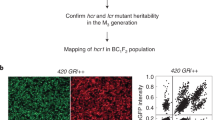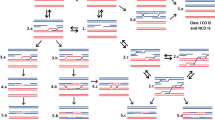Abstract
We experimented a novel reporter system to analyze intrachromosomal recombination between homeologous sequences in Arabidopsis germ cell lineages. The recombination substrates used are the BAR and PAT genes which diverge by about 13% at the nucleotide level and confer resistance to the herbicide glufosinate. DNA double-strand breaks (DSBs) were generated by the I-Sce1 endonuclease to induce recombination. Loss of AtMSH2 induces a 3-fold increase of the frequency of recombination events indicating that AtMSH2 is involved in the anti-recombination activity that prevents exchange between highly diverged sequences in Arabidopsis. Molecular analysis of recombined alleles indicates that in wild type plants the single strand annealing (SSA) pathway can process more efficiently homologous 3′ ends than 3′ ends generated by resection of non-homologous overhangs. The loss of AtMSH2 disturbs this process, leading to a modification of the distribution of the BAR/PAT junctions and therefore showing that the MSH2 function is also involved in determining the structure of the recombined alleles. In addition, conversion tracts were observed in some alleles. They are shorter in MSH2 deficient plants than in wild-type, suggesting that a short-patch mismatch repair, not controlled by MSH2, could exist in Arabidopsis.






Similar content being viewed by others
References
Aljabani SM, Martinez I (1997) Universal and rapid salt-extraction of high quality genomic DNA for PCR-based techniques. Nucleic Acids Res 25:4692–4693
Bechtold N, Pelletier G (1998) In planta Agrobacterium-mediated transformation of adult Arabidopsis thaliana plants by vacuum infiltration. Methods Mol Biol 82:259–266
Becker D (1990) Binary vectors which allow the exchange of plant selectable markers and reporter genes. Nucleic Acids Res 18:203
Becker D, Kemper E, Schell J, Masterson R (1992) New plant binary vectors with selectable markers located proximal to the left T-DNA border. Plant Mol Biol 20:1195–1197
Chen W, Jinks-Robertson S (1999) The role of the mismatch repair machinery in regulating mitotic and meiotic recombination between diverged sequences in yeast. Genetics 151:1299–1313
Chiurazzi M, Animesh R, Viret JF, Perea R, Wang XH, Lloyd AM, Signer E (1996) Enhancement of somatic intrachromosomal homologous recombination in Arabidopsis by the HO endonuclease. Plant Cell 8:2057–2066
Coïc E, Gluck L, Fabre F (2000) Evidence for short-patch mismatch repair in Saccharomyces cerevisiae. EMBO J 19:3408–3417
Datta A, Adjiri A, New L, Crouse GF, Jinks-Robertson S (1996) Mitotic crossovers between diverged sequences are regulated by mismatch repair proteins in Saccharomyces cerevisiae. Mol Cell Biol 16:1085–1093
Datta A, Hendrix M, Lipsitch M, Jinks-Robertson S (1997) Dual roles for DNA sequence identity and the mismatch repair system in the regulation of mitotic crossing-over in yeast. Proc Natl Acad Sci USA 94:9757–9762
Depeiges A, Degroote F, Espagnol MC, Picard G (2006) Translation initiation by non-AUG codons in Arabidopsis thaliana transgenic plants. Plant Cell Rep 25:55–61
Dubest S, Gallego ME, White CI (2002) Role of the AtRad1p endonuclease in homologous recombination in plants. EMBO Rep 3:1049–4054
Dubest S, Gallego ME, White CI (2004) Roles of the AtErcc1 protein in recombination. Plant J 39:334–342
Elliot B, Jasin M (2001) Repair of double-strand breaks by homologous recombination in mismatch repair-defective mammalian cells. Mol Cell Biol 21:2671–2682
Emmanuel E, Yehuda E, Melamed-Bessudo C, Avivi-Ragolsky N, Levy A (2006) The role of AtMSH2 in homologous recombination in Arabidopsis thaliana. EMBO Rep 7:100–104
Fleck O, Lehmann E, Schar P, Kohli L (1999) Involvement of nucleotide-excision repair in MSH2 PMS1-independent mismatch repair. Nat Genet 21:314–317
Goldfarb T, Alani E, (2005) Distinct roles for the Saccharomyces cerevisiae mismatch repair proteins in heteroduplex rejection, mismatch repair and non homologous tail removal. Genetics 169:563–574
Gorbunova V, Levy A (1999) How plants make ends meet: DNA double-strands break repair. Trends Plant Sci 4:263–269
Harfe BD, Jinks-Robertson S (2000) DNA mismatch repair and genetic instability. Annu Rev Genet 34:359–399
Hoffman PD, Leonard JM, Lindberg GE, Bollmann SR, Hays JB (2004) Rapid accumulation of mutations during seed-to-seed propagation of mismatch-repair-defective Arabidopsis. Genes Dev. 18:2676–2685
Leonard JM, Bollmann SR, Hays JB (2003) Reduction of stability of Arabidopsis genomic and transgenic DNA-repeat sequences (microsatellites) by inactivation of AtMSH2 mismatch-repair function. Plant Physiol 133:328–338
Li L, Santerre-Ayotte S, Boivin EB, Jean M, Belzile F (2004) A novel reporter for intrachromosomal homeologous recombination in Arabidopsis thaliana. Plant J 40:1007–1015
Li L, Jean M, Belzile F (2006) The impact of sequence divergence and DNA mismatch repair on homeologous recombination in Arabidopsis. Plant J 45:908–916
Muheim-Lenz R, Buterin T, Marra G, Naegeli H (2004) Short-patch correction of C-C mismatches in human cells. Nucleic Acids Res 32:6696–6705
Modrich P, Lahue R (1996) Mismatch repair in replication fidelity, genetic recombination and cancer biology. Annu Rev Biochem 65:101–133
Nicholson A, Hendrix M, Jinks-Robertson S, Crouse GH (2000) Regulation of mitotic homeologous recombination in yeast: Functions of mismatch repair and nucleotide excision repair genes. Genetics 154:133–146
Oda S, Humbert O, Fiumicino S, Bignami M, Karran P (2000) Efficient repair of A/C mismatches in mouse cells deficient in long patch mismatch repair. EMBO J 19:1711–1718
Opperman R, Emmanuel E, Levy AA (2004) The effect of sequence divergence on recombination between direct repeats in Arabidopsis. Genetics 168:2207–2215
Orel N, Kyryk A, Puchta H (2003) Different pathways of homologous recombination are used for the repair of double-stand breaks within tandemly arranged sequences in the plant genome. Plant J 35:604–612
Pâques F, Haber JE (1997) Two pathways for removal of nonhomologous DNA ends during double-strand break repair in Saccharomyces cerevisiae. Mol Cell Biol 17:6765–6771
Puchta H (1998) Repair of genomic double-strand breaks in somatic plant cells by one-sided invasion of homologous sequences. Plant J 13:331–339
Puchta H (2005) The repair of double-strand breaks in plants: mechanisms and consequences for genome evolution. J Exp Bot 56:1–14
Puchta H, Dujon B, Hohn B (1993) Homologous recombination in plant cells is enhanced by in vivo induction of double strand breaks into DNA by a site-specific endonuclease. Nucleic Acids Res 21:5034–5040
Puchta H, Dujon B, Hohn B (1996) Two different but related mechanisms are used in plants for the repair of double-strand breaks by homologous recombination. Genetics 93:5055–5060
Ray A, Langer M (2002) Homologous recombination: ends as the means. Trends Plant Sci 7:435–440
Rayssiguier C, Thaler DS, Radman M (1989) The barrier to recombination between Escherichia coli and Salmonella typhimurium is disrupted in mismatch-repair mutants. Nature 342:396–401
Schoffield MJ, Hsieh P (2003) DNA mismatch repair: molecular mechanisms and biological function. Annu Rev Microbiol 57:579–608
Siebert R, Puchta H (2002) Efficient repair of genomic double-strand breaks by homologous recombination between directly repeated sequences in the plant genome. Plant Cell 14:1121–1131
Stambuk S, Radman M (1998) Mechanism and control of interspecies recombination in Escherichia coli. I. Mismatch repair, methylation, recombination and replication functions. Genetics 150:533–542
Sugawara N, Pâques F, Colaiacovo M, Haber J (1997) Role of Saccharomyces cerevisiae Msh2 and Msh3 repair proteins in double-strand break-induced recombination. Proc Natl Acad Sci USA 94:9214–9219
Sugawara N, Goldfarb T, Studamire B, Alani E, Haber J (2004) Heteroduplex rejection during single-strand annealing requires Sgs1 helicase and mismatch repair proteins Msh2 and Msh6 but not Pms1. Proc Natl Acad Sci USA 101:9315–9320
Thierry A, Fairhead C, Dujon B (1990) The complete sequence of the 8.2 kb segment left of MAT on chromosome III reveals five ORFs, including a gene for yeast ribokinase. Yeast 6:521–534
Trouiller B, Schaefer DG, Charlot F, Nogué F (2006) MSH2 is essential for the preservation of genome integrity and prevents homeologous recombination in the moss physcomitella patens. Nucleic Acids Res 34:232–242
White J, Chang SHP, Bibb MJ, Bibb MJ (1990) A cassette containing the bar gene of Streptomyces hygroscopicus: a selectable marker for plant transformation. Nucleic Acids Res 18:1062
Westmoreland J, Porter G, Radman M, Resnick MA (1997) Highly mismatched molecules resembling recombination intermediates efficiently transform mismatch repair proficient Escherichia coli. Genetics 145:29–38
Wohlleben W, Arnold W, Broer I, Hilleman D, Strauch E, Pühler A (1988) Nucleotide sequence of the phosphinithricin N-acetyltransferase gene from Streptomyces viridochromogenes Tü494 and its expression in Nicotiana tabacum. Gene 70:25–37
Zahrt TC, Maloy S (1997) Barriers to recombination between closely related bacteria: MutS and RecBCD inhibit recombination between Salmonella typhimurium and Salmonella typhi. Proc Natl Acad Sci USA 94:9786–9791
Acknowledgements
The authors thank Dr. Charles White for critical reading of the manuscript, Dr. Bernard Dujon and Dr. Pascual Perez (Biogemma) for kindly providing plasmids pBios-1K and pSCM525. This work was supported by the Centre National de la Recherche Scientifique (CNRS) and by the Université Blaise-Pascal.
Author information
Authors and Affiliations
Corresponding author
Rights and permissions
About this article
Cite this article
Lafleuriel, J., Degroote, F., Depeiges, A. et al. Impact of the loss of AtMSH2 on double-strand break-induced recombination between highly diverged homeologous sequences in Arabidopsis thaliana germinal tissues. Plant Mol Biol 63, 833–846 (2007). https://doi.org/10.1007/s11103-006-9128-5
Received:
Accepted:
Published:
Issue Date:
DOI: https://doi.org/10.1007/s11103-006-9128-5




